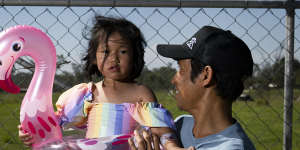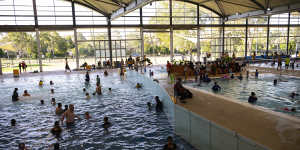In Randwick,residents have a choice of nine ocean or man-made pools,ranging from historic Wylies Baths to the modern Des Renford Aquatic Centre. There is a council-managed bathing spot for every 17,200 people;by 2041,they’ll need to squeeze in an extra 1700.
In Penrith,there are two council-run pools;they are far more crowded. There’s one per 108,000 people,and by 2041 that will grow to 135,000 people for each swimming spot,according to NSW Department of Planning figures.

Daniyah Duran is among those missing out on swimming classes because there are not enough pools. She is pictured with her father Ronald where there would be an aquatic centre if Blacktown Council could afford to build it.Wolter Peeters
In the rapidly growing Blacktown council area,there are five public pools;that’s one per 77,000 residents. The population is growing so fast that unless more are built,there will be 100,000 people per pool in less than 20 years.
Yet in riverside Lane Cove,with its more modest growth forecast,the number of people per pool (or baths) will rise only slightly from 23,000 to 23,790.

Tony Bleasdale,the mayor of Blacktown Council – which calculated the figures using pools,baths and netted beaches – thinks this is unfair. His residents live further away from the coast and endure hotter temperatures,yet have fewer aquatic options when they want to cool down.
“It’s about making sure there’s a level of equity,and making sure western Sydney residents are not forced to endure being denied these facilities. We have five swimming pool complexes for 410,000 people. How many people can you put in a pool?” he said.
“We need to make sure people have sporting fields,swimming pools and the like so they can enjoy a lifestyle that others in Sydney are enjoying.”
The north- and south-west growth districts,covered by councils such as Blacktown and Camden,have rapidly growing populations as new suburbs are built,and residents say facilities –.
Suburbs in these areas also have the highest proportion of children under 10. They include Bardia in the Campbelltown area,where newborns to those aged nine make up almost 25 per cent,Oran Park in the south-west (22.8 per cent) and Marsden Park (22.7 per cent).

Samantha Felstein from Blacktown Leisure Centre said the learn-to-swim team could not cope with demand. When the latest term began,there were no vacancies for primary-aged children,and only a few for adults and preschoolers.
“We are dealing with hundreds of customers a week coming through and asking to book classes,and constant disappointment from them when we don’t have the vacancy to cater for them,” she said.
Sebastian Pfautsch,a Western Sydney University associate professor who studies intensive heat in the city’s west,said the disparity between pool facilities in the east and west was “quite shocking”.
“The[better-served areas] don’t just have the pools,they have kilometres of shoreline,” he said.
“Overseas,there are policies that speak about longer opening hours for pools,and making them free,during heatwave days,but if we don’t have the pools,it’s just silly.”
In NSW,there are 445 public pools,plus 213 pools that are publicly accessible,such as private learn-to-swim pools. That’s 658 pools across the state,with an average of 12,400 users each.
Blacktown has a plot of land set aside for an aquatic centre at Marsden Park,but Bleasdale said the council could not afford to build it. In the lead-up to the election,the council is calling on both major parties to commit to changes to developer levy rules that would allow that to happen.

Blacktown Council wants to build more pools but says it cannot afford to because of limits on developer levies.Wolter Peeters
Labor capped developer levies in 2010,and the cap remains. The levies are only allowed to be spent on particular types of infrastructure. For example,council can use the money to buy land for a pool,but not the pool itself.
Blacktown is calling on the next government to restore the pre-2010 funding mechanism,saying it has a backlog of $525 million in projects it cannot build. Local Government NSW to be able to spend the levies on a wider range of community needs.
“You’ll have more pressure on the existing infrastructure,if in fact governments don’t allow councils to build these facilities,” Bleasdale said.
Ronald Duran,who was once a merchant seaman in the Philippines,is a keen swimmer himself,but he wants the rest of his family to be proficient swimmers,too. “I want to get my daughter to learn to swim,but there are no places anywhere,” he said. “Also my wife can’t swim but we can’t get a place for her,either.”
Royal Lifesaving Society NSW chief executive Michael Ilinsky said governments needed to start building pools in fast-growing areas now,given they were expensive and took years to develop. He said they provided important mental,physical and social benefits while they also played a key role in drowning prevention.
He said 35 per cent of people born overseas identified as non or poor swimmers – which made access to pools in diverse communities in south-west and western Sydney even more vital – and urged both major parties to make pre-election commitments to build new swimming pools in growth areas.
A Labor spokesperson said the party understood the pressures faced by councils and,if elected,would look at options with councils to let local governments deliver infrastructure more quickly.
“We will task the Greater Cities Commission to rebalance housing targets and setting new targets around metro lines to help provide housing around existing infrastructure,” the spokesperson said.
A spokesperson for Planning and Homes Minister Anthony Roberts said reforms to infrastructure contribution laws had been put on hold so the department could work on amendments to improve the system. An amended package would be introduced this year,the spokesperson said.
The Morning Edition newsletter is our guide to the day’s most important and interesting stories,analysis and insights..